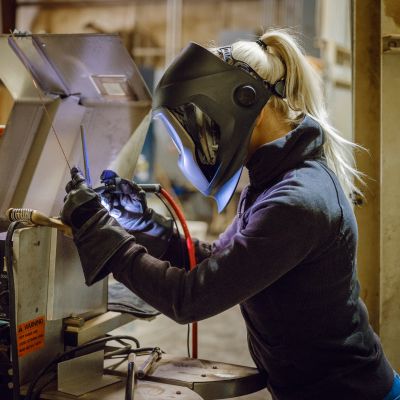Any job site can be a dangerous place for your eyes. Flying debris and other dangers lurk around every corner. If you’re a welder, your job can be a major threat to your health. Not only are you working with flames, but the light it produces can damage your eyes in significant ways. This is known as welder’s flash and it can have long-term effects on your eyes without proper protection.
What is Welder’s Flash?
Welder’s flash occurs when your eyes are exposed to UV light without proper protection. Also known as arc eye, it’s medically known as photokeratitis, which is a sunburn on your eye. The condition is unique because it’s caused by UV radiation from the welding arc rather than the sun, light reflected off of surfaces, or from another artificial source.
Click here to learn how you can get a sunburn on your eyes!
Symptoms
You can develop a flash burn in as little as 30 minutes. However, welder’s flash symptoms can take as long as 12 hours to develop before you notice any issues.
The most common symptom is eye pain. Your eyes may become sensitive to light as long as the burn is present. Headaches are another common symptom and feeling like something is stuck in your eye. Affected individuals often describe the sensation as feeling like you have a piece of sand in your eye. One or both eyes may be affected by light from the blow torch.
Other symptoms include:
- Reduced vision
- Blurred vision
- Red eyelids
- Increased tear production
Eye pain, light sensitivity, irritation, and reddened eyes are common symptoms of other eye problems such as pink eye. They could also be the result of contact with an irritating substance on the job site or from wearing contact lenses for too long. For the right treatment, you will need a diagnosis from Dr. Travis Thompson or Dr. Catherine Abbott.
To learn about the convenience of daily contacts, click here!
Causes
Like other types of photokeratitis, welder’s flash is caused by unprotected exposure to UV rays. In this case, the UV rays are coming from bright flashes of light that occur when welding. These rays damage the thin outer layer of your cornea (epithelium) where light enters your eye. This layer is also important for preventing dry eye by spreading tears to keep eyes moist. Damage from welder’s flash leaves the nerves of the cornea exposed, resulting in severe eye pain.
To learn about other ways you can develop photokeratitis, click here!
Prevention
Welder’s flash, along with other types of welding injuries, is easily prevented with the use of personal protective equipment. When you wear eye protection such as welding helmets, you are also able to prevent welder injuries including flying particles entering your eyes. Welding helmets and other protective equipment are essential for safety on any job site.
Treatment
Eye injuries related to welder’s flesh or sunburns on the eyes can be treated at home in most cases. If anything like this happens to you, go indoors as soon as possible and keep the room dark. Take out your contact lenses if you wear them and use glasses until your symptoms are gone. You should also avoid rubbing your eyes.
You can alleviate your symptoms in a few different ways, such as:
- Taking over-the-counter pain relievers
- Using artificial tears
- Applying a cold compress to your closed eyes
This could be enough treatment in most cases and your symptoms may recede in a few hours or days.
However, you should see your eye doctor if you experience pain for more than two days or notice vision loss. They will prescribe antibiotic eye drops to reduce the risk of infection and promote faster healing. Use these eye drops as directed, which may include using them throughout the day over the span of a few days.
If you experience welder’s flash, proactively visiting Hardin Valley Eyecare & Optical as soon as you notice your first symptoms is a great idea to maximize recovery time.
The Long-Term Risks of UV Exposure
Exposure to UV rays can result in more serious problems than temporary discomfort. Prolonged exposure can increase your risk of chronic vision problems such as:
- Cataracts
- Macular degeneration
- Pinguecula
- Pterygia
Cataracts are a natural part of aging where the proteins in the lens of the eye begin to break down and clump together, causing clouded vision. Extended exposure to UV light speeds up this process, causing it to happen sooner rather than later.
Macular degeneration is a condition in which a section of the retina known as the macula begins to deteriorate resulting in vision loss. The blue light associated with UV rays can actually accelerate this process, causing the macula to deteriorate faster than normal.
Pinguecula is a raised growth, usually white or yellow in color, that grows on the white part of your eye (conjunctiva). It’s suspected to be caused by extended exposure to sunlight, dust, and wind. Pterygia, also known as surfer’s eye, is thought to have similar causes. It can appear as a pink, white, or red growth extending from the white of the eye to the cornea.
Do you need protection from the effects of UV radiation? Contact us today to schedule an appointment!
Welder’s flash is caused by exposing your eyes to UV radiation when welding. Common symptoms include eye pain, light sensitivity, and headaches. This is due to the thinning of the cornea which increases sensitivity. It is easily preventable with the use of proper eye protection. It can be treated at home but severe cases may require medical treatment. Long-term UV exposure can increase your risk of cataracts, macular degeneration, and other conditions.
Hardin Valley Eyecare & Optical has been serving Knoxville since 2009. Dr. Travis Thompson and Dr. Catherine Abbott specialize in the diagnosis and treatment of a wide array of eye diseases, conditions, and problems and are committed to improving the quality of life in the Knoxville community through enhanced vision. Located at 10904 Spring Bluff Way, you can schedule an appointment online or give us a call at (865) 888-0892.





